Impact of the Location and Energy Carriers Used on Greenhouse Gas Emissions from a Building
Abstract
:1. Introduction
2. Materials and Methods
2.1. Research Facility
2.2. Measuring Apparatus
2.3. Numerical Analysis
- C—total heat capacity of an element [J·K−1];
- θk+1—time step temperature k + 1 [K];
- θk—time step temperature k [K];
- Δτ—time step [s];
- A—surface area through which heat flows between elements [m2];
- R—thermal resistance [m2·K·W−1].
2.4. Facility Pollutant Emissions
- B—annual fuel demand [kg·year−1];
- Q—annual heat demand [MJ];
- Wo—fuel calorific value [MJ·year−1];
- η—boiler efficiency [–].
- E—pollutant emission [kg];
- B—annual fuel demand [Mg];
- Wo—calorific value [kJ·year−1];
- EF—emission factor [g·GJ−1].
- L—livestock density [pcs.];
- 0.0036—Conversion rate of actual broiler chickens to LCU.
3. Results
3.1. Validation of the Computational Model
3.2. Calculation of Energy and Fuel Demand
3.3. Emission of Pollutants from an Individual Building
3.4. Pollutant Emissions per 1 Livestock Unit (LCU)
4. Discussion
5. Conclusions
Author Contributions
Funding
Data Availability Statement
Conflicts of Interest
Nomenclature
| Δτ | time interval; |
| i | element number; |
| Φixiyiz, | heat flux between ix, iy, iz and adjacent elements [W]; |
| C | total heat capacity of an element [J·K−1]; |
| θk+1 | time step temperature k + 1 [K]; |
| θk | time step temperature k [K]; |
| Δτ | time step [s]; |
| A | surface area through which heat flows between elements [m2]; |
| R | thermal resistance [m2·K·W−1]; |
| B | annual fuel demand [kg·year−1]; |
| Q | annual heat demand [MJ]; |
| Wo | fuel calorific value [MJ·year−1]; |
| η | boiler efficiency [–]; |
| E | pollutant emission [kg]; |
| Wo | calorific value [kJ·year−1]; |
| EF | emission factor [g·GJ−1]; |
| L | livestock density [pcs]. |
References
- Magazzino, C.; Cerulli, G.; Haouas, I.; Unuofin, J.O.; Sarkodie, S.A. The drivers of GHG emissions: A novel approach to estimate emissions using nonparametric analysis. Gondwana Res. 2023, 127, 4–21. [Google Scholar] [CrossRef]
- Dunkley, C.S.; Fairchild, B.D.; Ritz, C.W.; Kiepper, B.H.; Lacy, M.P. Carbon footprint of poultry production farms in South Georgia: A case study. J. Appl. Poult. Res. 2015, 24, 73–79. [Google Scholar] [CrossRef]
- Forero-Cantor, G.; Ribal, J.; Sanjuán, N. Levying carbon footprint taxes on animal-sourced foods. A case study in Spain. J. Clean. Prod. 2020, 243, 118668. [Google Scholar] [CrossRef]
- Sokołowski, P.; Nawalany, G. Analysis of Energy Exchange with the Ground in a Two-Chamber Vegetable Cold Store, Assuming Different Lengths of Technological Break, with the Use of a Numerical Calculation Method—A Case Study. Energies 2020, 13, 4970. [Google Scholar] [CrossRef]
- Rondoni, A.; Grasso, S. Consumers behaviour towards carbon footprint labels on food: A review of the literature and discussion of industry implications. J. Clean. Prod. 2021, 301, 127031. [Google Scholar] [CrossRef]
- Kler, R.; Gangurde, R.; Elmirzaev, S.; Hossain, M.S.; Vo, N.V.T.; Nguyen, T.V.T.; Kumar, P.N. Optimization of meat and poultry farm inventory stock using data analytics for green supply chain network. Discret. Dyn. Nat. Soc. 2022, 2022, 8970549. [Google Scholar] [CrossRef]
- Shabir, I.; Dash, K.; Dar, A.; Pandey, V.K.; Fayaz, U.; Srivastava, S.; Nisha, R. Carbon footprints evaluation for sustainable food processing system development: A comprehensive review. Future Foods 2023, 7, 100215. [Google Scholar] [CrossRef]
- Minoofar, A.; Gholami, A.; Eslami, S.; Hajizadeh, A.; Gholami, A.; Zandi, M.; Ameri, M.; Kazem, H.A. Renewable energy system opportunities: A sustainable solution toward cleaner production and reducing carbon footprint of large-scale dairy farms. Energy Convers. Manag. 2023, 293, 117554. [Google Scholar] [CrossRef]
- Poore, J.; Nemecek, T. Reducing food’s environmental impacts through producers and consumers. Science 2018, 360, 987–992. [Google Scholar] [CrossRef]
- Usva, K.; Hietala, S.; Nousiainen, J.; Vorne, V.; Vieraankivi, M.L.; Jallinoja, M.; Leinonen, I. Environmental life cycle assessment of Finnish broiler chicken production–Focus on climate change and water scarcity impacts. J. Clean. Prod. 2023, 410, 137097. [Google Scholar] [CrossRef]
- Pelletier, N. Environmental performance in the US broiler poultry sector: Life cycle energy use and greenhouse gas, ozone depleting, acidifying and eutrophying emissions. Agric. Syst. 2008, 98, 67–73. [Google Scholar] [CrossRef]
- Pestisha, A.; Gabnai, Z.; Chalgynbayeva, A.; Lengyel, P.; Bai, A. On-Farm Renewable Energy Systems: A Systematic Review. Energies 2023, 16, 862. [Google Scholar] [CrossRef]
- Tucki, K.; Orynycz, O.; Wasiak, A.; Świć, A.; Mieszkalski, L.; Wichłacz, J. Low Emissions Resulting from Combustion of Forest Biomass in a Small Scale Heating Device. Energies 2020, 13, 5495. [Google Scholar] [CrossRef]
- Nawalany, G.; Sokołowski, P.; Michalik, M. The effect of floor material and construction solutions and the type of heating system on greenhouse gas (GHG) emissions—A case study. J. Build. Eng. 2023, 77, 107422. [Google Scholar] [CrossRef]
- Mirowski, T.; Orzechowska, M. The use of biomass fuels in individual heating in areas threatened by low emission. Polityka Energetyczna Energy Policy J. 2015, 18, 75–88. [Google Scholar]
- Nawalany, G.; Lendelova, J.; Sokołowski, P.; Zitnak, M. Numerical Analysis of the Impact of the Location of a Commercial Broiler House on Its Energy Management and Heat Exchange with the Ground. Energies 2021, 14, 8565. [Google Scholar] [CrossRef]
- Nawalany, G.; Bieda, W.; Radoń, J. Effect of floor heating and cooling of bedding on thermal conditions in the living area of broiler chickens. Arch. Geflügelk. 2010, 74, 98–101. [Google Scholar]
- Costantino, A.; Fabrizio, E.; Ghiggini, A.; Bariani, M. Climate control in broiler houses: A thermal model for the calculation of the energy use and indoor environmental conditions. Energy Build. 2018, 169, 110–126. [Google Scholar] [CrossRef]
- Izar-Tenorio, J.; Jaramillo, P.; Griffin, W.; Small, M. Impacts of projected climate change scenarios on heating and cooling demand for industrial broiler chicken farming in the Eastern U.S. J. Clean. Prod. 2020, 255, 120306. [Google Scholar] [CrossRef]
- Costantino, A. Development, Validation, and Application of Building Energy Simulation Models for Livestock Houses: A Systematic Review. Agriculture 2023, 13, 2280. [Google Scholar] [CrossRef]
- Qi, F.; Zhao, X.; Shi, Z.; Li, H.; Zhao, W. Environmental Factor Detection and Analysis Technologies in Livestock and Poultry Houses: A Review. Agriculture 2023, 13, 1489. [Google Scholar] [CrossRef]
- Vanbaelinghem, L.; Costantino, A.; Grassauer, F.; Pelletier, N. Alternative Heating, Ventilation, and Air Conditioning (HVAC) System Considerations for Reducing Energy Use and Emissions in Egg Industries in Temperate and Continental Climates: A Systematic Review of Current Systems, Insights, and Future Directions. Sustainability 2024, 16, 4895. [Google Scholar] [CrossRef]
- Boutera, Y.; Boultif, N.; Moummi, N.; Arıcı, M.; Saleh, M.; Rouag, A.; Kethiri, M.; Beldjani, C. Evaluation of the earth-air heat exchanger’s performance in improving the indoor conditions of an industrial poultry house using computational fluid dynamics verified with field tests. J. Clean. Prod. 2024, 434, 140218. [Google Scholar] [CrossRef]
- Wartości Opałowe (WO) i Wskaźniki Emisji CO2 (WE) w Roku 2020 do Raportowania w Ramach Wspólnotowego Systemu Handlu Uprawnieniami do Emisji za Rok 2023; KOBiZE: Warszawa, Poland, 2021.
- Wskaźniki Emisji Zanieczyszczeń ze Spalania Paliw dla Źródeł o Nominalnej Mocy Cieplnej do 5 MW, Zastosowane do Automatycznego Wyliczenia Emisji w Raporcie do Krajowej Bazy za 2022 r; KOBiZE: Warszawa, Poland, 2022.
- Directive 2003/87/EC; Directive 2003/87/EC of the European Parliament and of the Council of 13 October 2003 Establishing a Scheme for Greenhouse Gas Emission Allowance Trading within the Community and Amending Council Directive 96/61/EC. European Union: Brussels, Belgium, 2003.
- Marzec, E. Analiza energetyczna i ekologiczna zastosowania wybranych systemów ogrzewania domu jednorodzinnego. Arch. Inst. Tech. Ciepl. 2016, 2, 87–109. [Google Scholar]
- Council of Ministers Regulation of January 31, 2023 on the “Program of Measures to Reduce Water Pollution by Nitrates from Agricultural Sources and Prevent Further Pollution”. Available online: https://sip.lex.pl/akty-prawne/dzu-dziennik-ustaw/program-dzialan-majacych-na-celu-zmniejszenie-zanieczyszczenia-wod-21790383 (accessed on 15 September 2024).
- Nawalany, G.; Sokołowski, P. Improved Energy Management in an Intermittently Heated Building Using a Large Broiler House in Central Europe as an Example. Energies 2020, 13, 1371. [Google Scholar] [CrossRef]
- Available online: https://agridata.ec.europa.eu/extensions/DashboardPoultry/PoultryProduction.html (accessed on 6 February 2024).
- Elahi, E.; Khalid, Z.; Zhang, Z. Understanding farmers’ intention and willingness to install renewable energy technology: A solution to reduce the environmental emissions of agriculture. Appl. Energy 2022, 309, 118459. [Google Scholar] [CrossRef]
- Wierzbińska, M.; Adamus, A. Wpływ rodzaju spalanego paliwa oraz urządzenia grzewczego na jakość powietrza atmosferycznego. Ecol. Eng. 2020, 21, 17–25. [Google Scholar]
- Li, Z.; Wu, L.; Xu, Y.; Zheng, X. Stochastic-Weighted Robust Optimization Based Bilayer Operation of a Multi-Energy Building Microgrid Considering Practical Thermal Loads and Battery Degradation. IEEE Trans. Sustain. Energy 2022, 13, 668–682. [Google Scholar] [CrossRef]
- Ding, B.; Li, Z.; Li, Z.; Xue, Y.; Chang, X.; Su, J.; Jin, X.; Sun, H. A CCP-based distributed cooperative operation strategy for multi-agent energy systems integrated with wind, solar, and buildings. Appl. Energy 2024, 365, 123275. [Google Scholar] [CrossRef]
- Nawalany, G.; Sokołowski, P. Interaction between a Cyclically Heated Building and the Ground, for Selected Locations in Europe. Energies 2022, 15, 7493. [Google Scholar] [CrossRef]
- Cui, Y.; Theo, E.; Gurler, T.; Su, Y.; Saffa, R. Feasibility of hybrid renewable heating system application in poultry house: A case study of East Midlands, UK. Int. J. Low-Carbon Technol. 2020, 16, 73–88. [Google Scholar] [CrossRef]
- Ramos-Suárez, J.L.; Ritter, A.; Mata González, J.; Camacho Pérez, A. Biogas from animal manure: A sustainable energy opportunity in the Canary Islands. Renew. Sustain. Energy Rev. 2019, 104, 137–150. [Google Scholar] [CrossRef]
- Sobczak, A.; Chomać-Pierzecka, E.; Kokiel, A.; Różycka, M.; Stasiak, J.; Soboń, D. Economic Conditions of Using Biodegradable Waste for Biogas Production, Using the Example of Poland and Germany. Energies 2022, 15, 5239. [Google Scholar] [CrossRef]




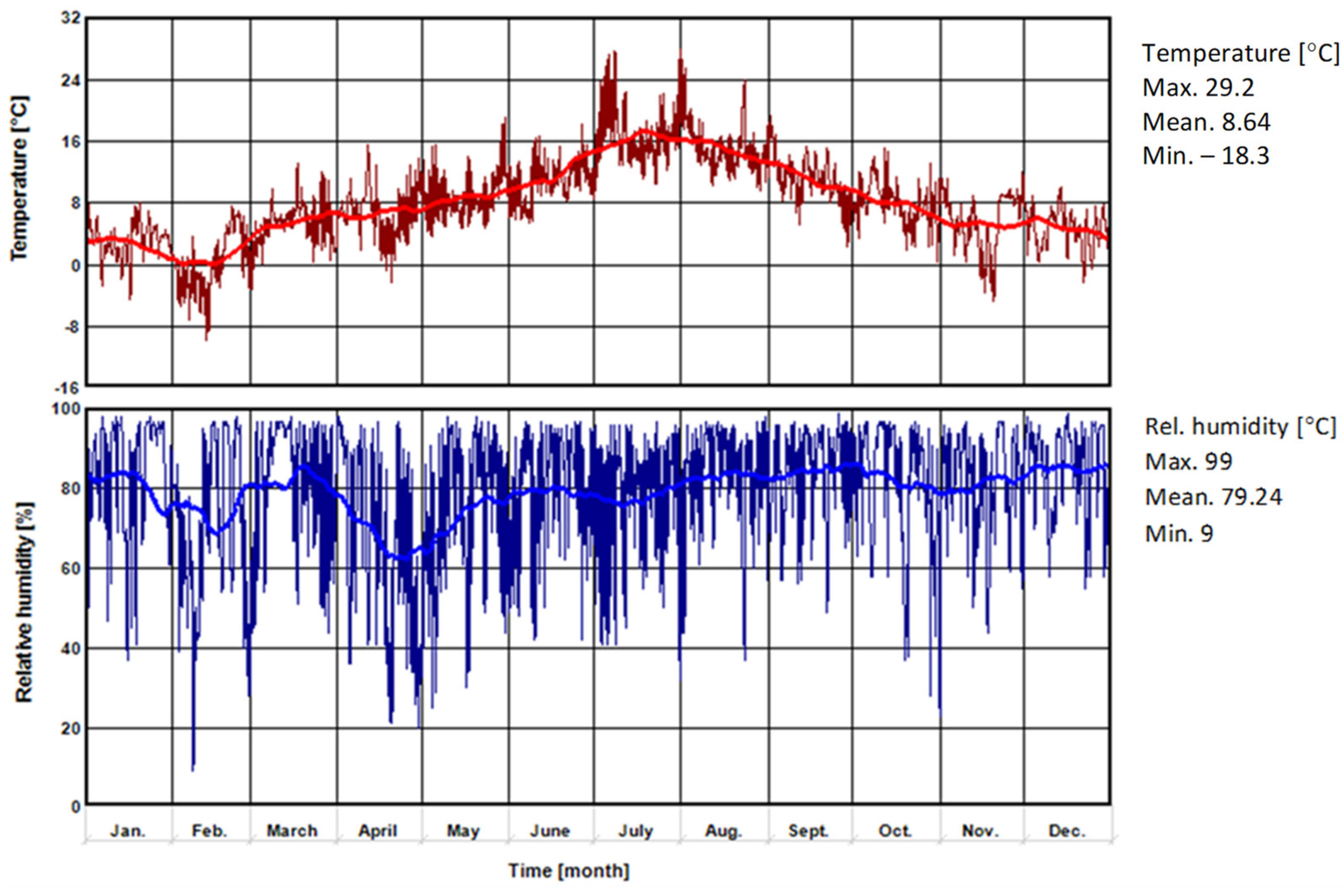




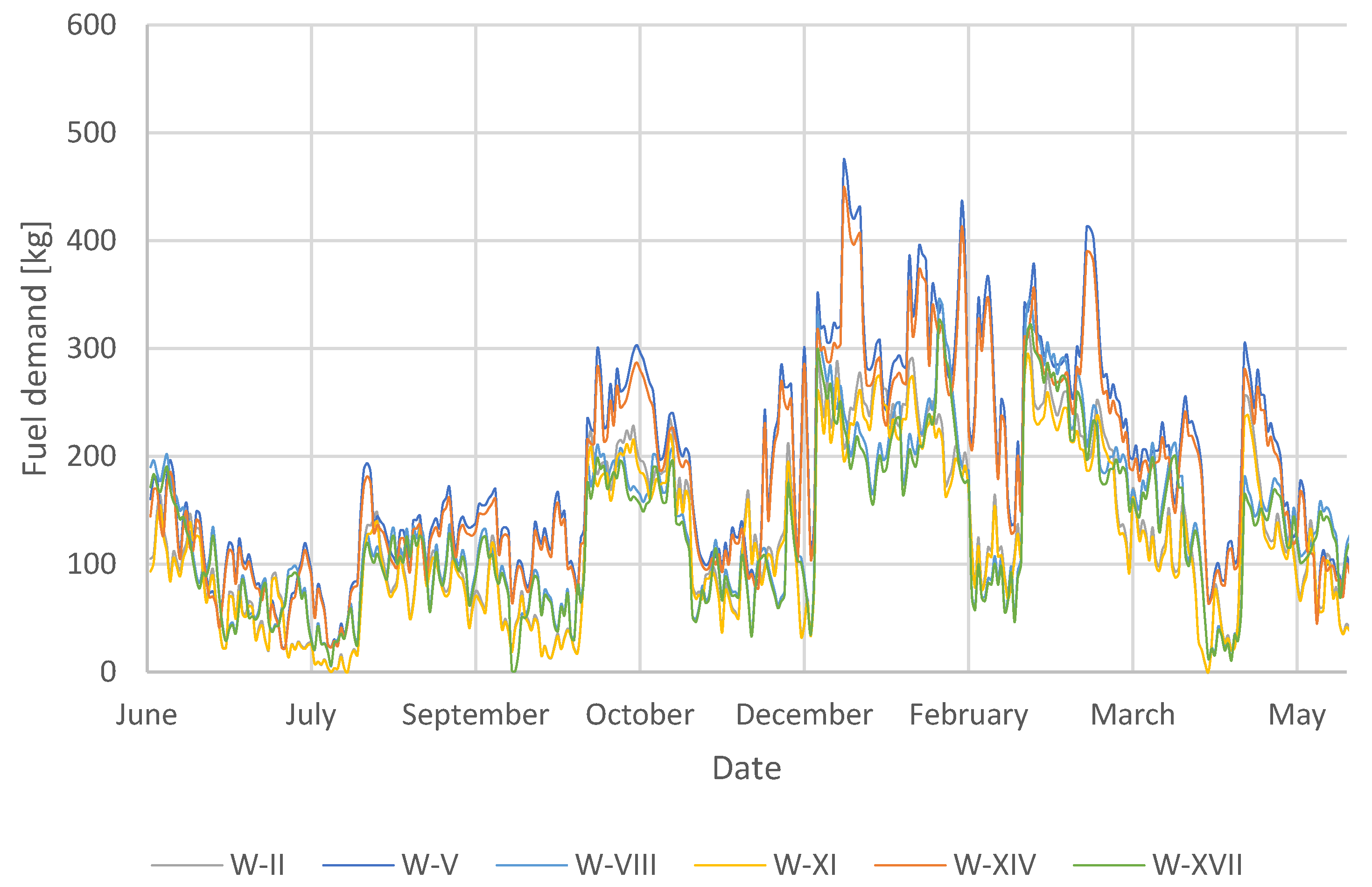

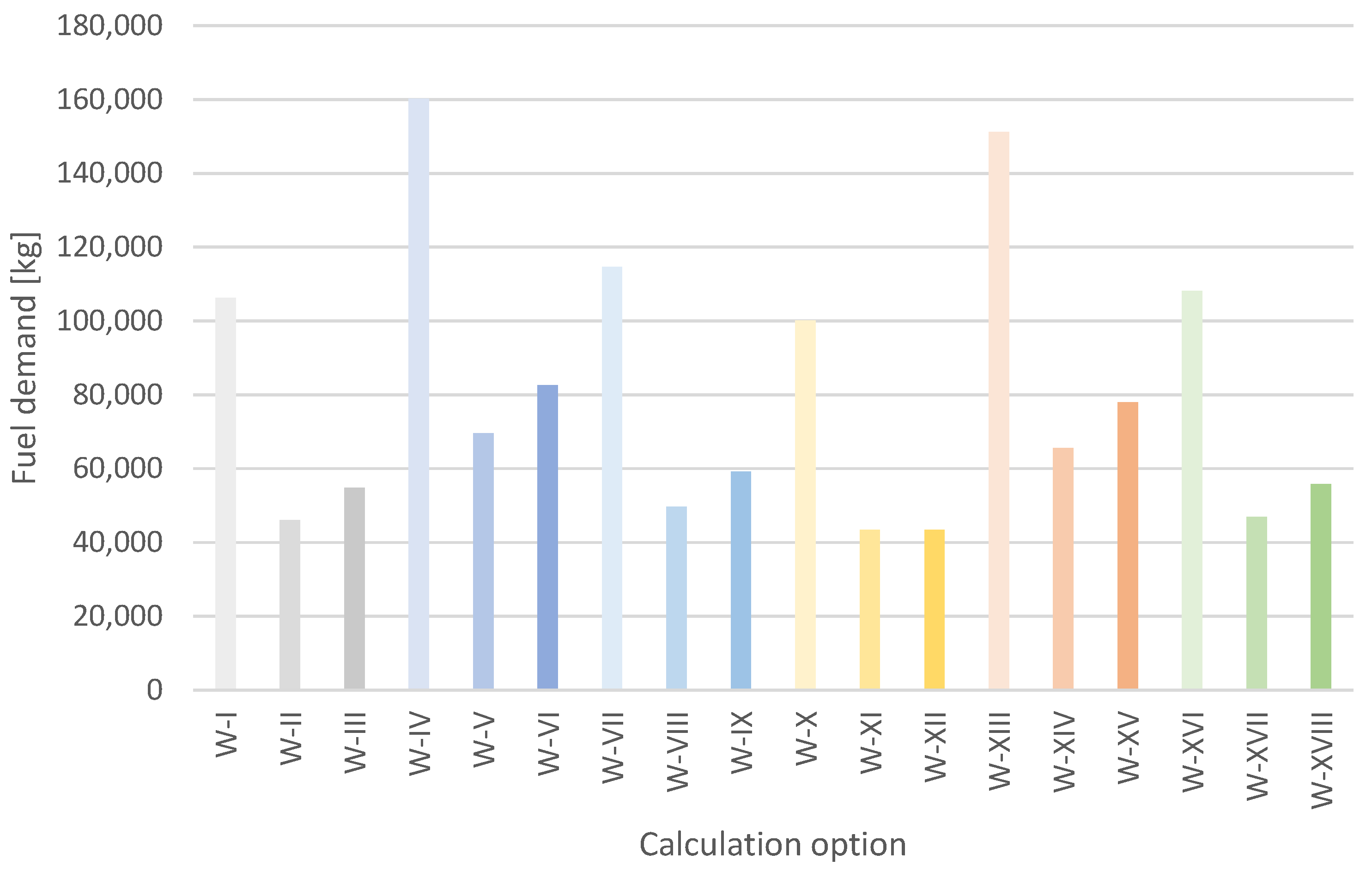
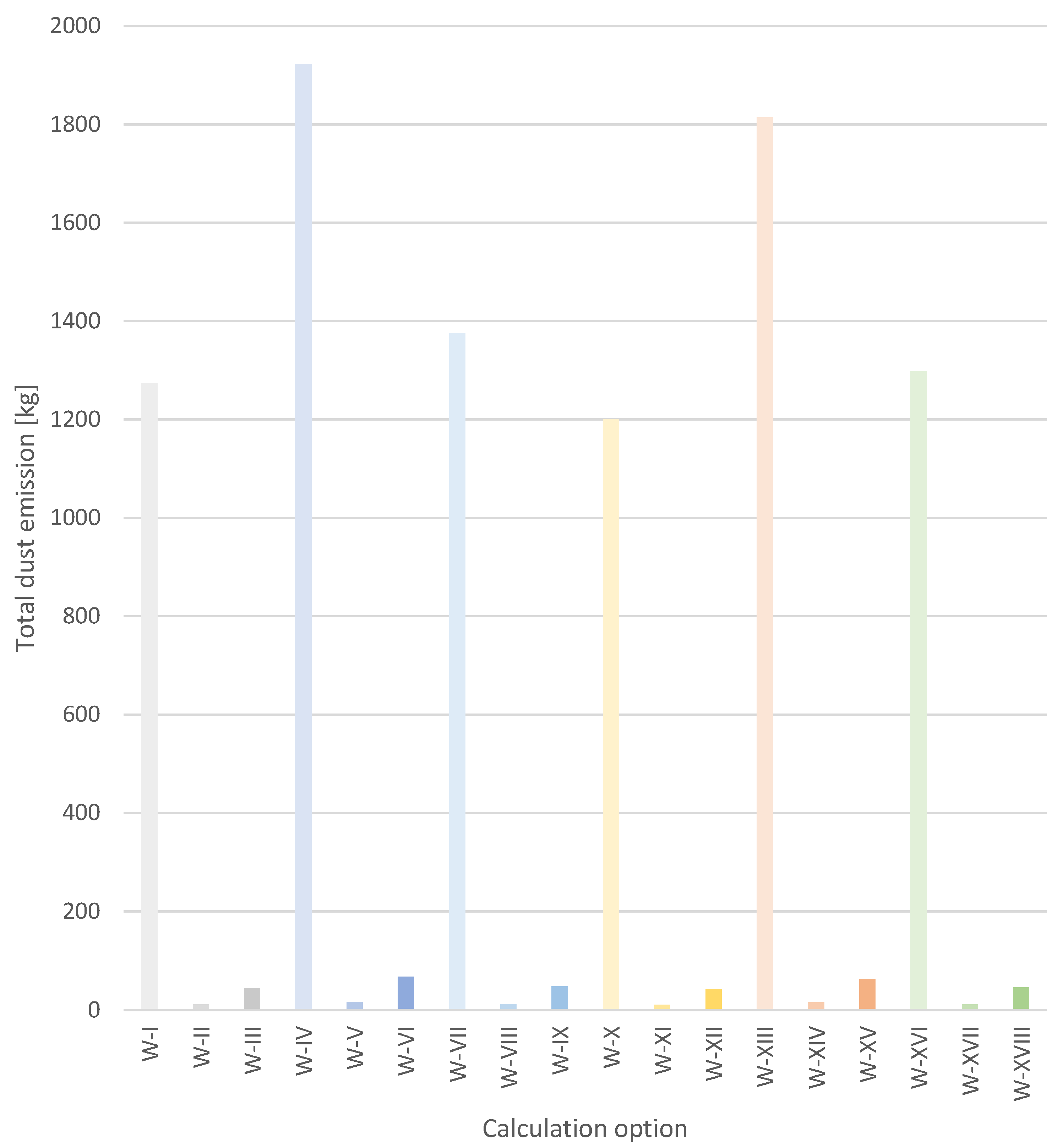


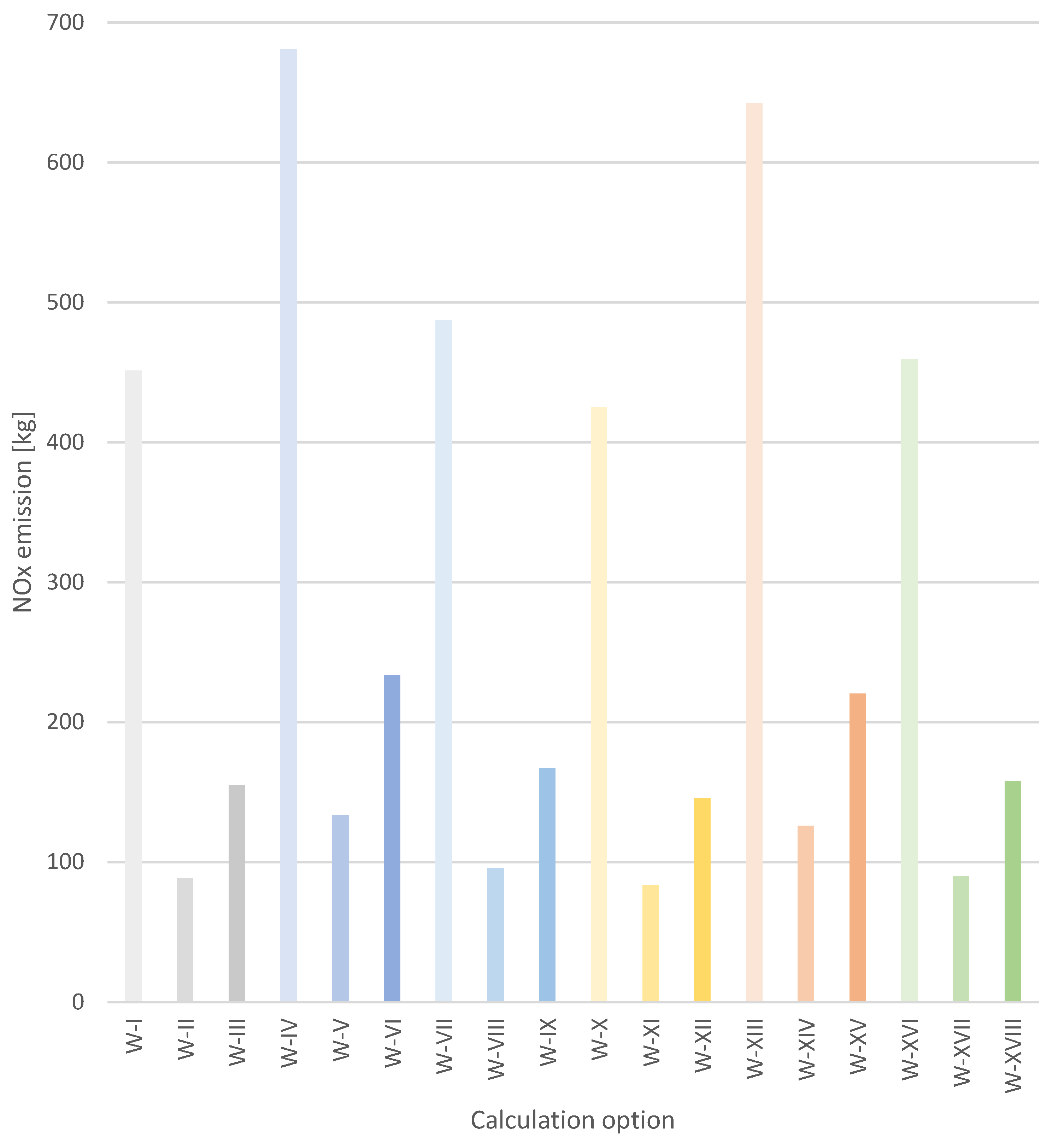
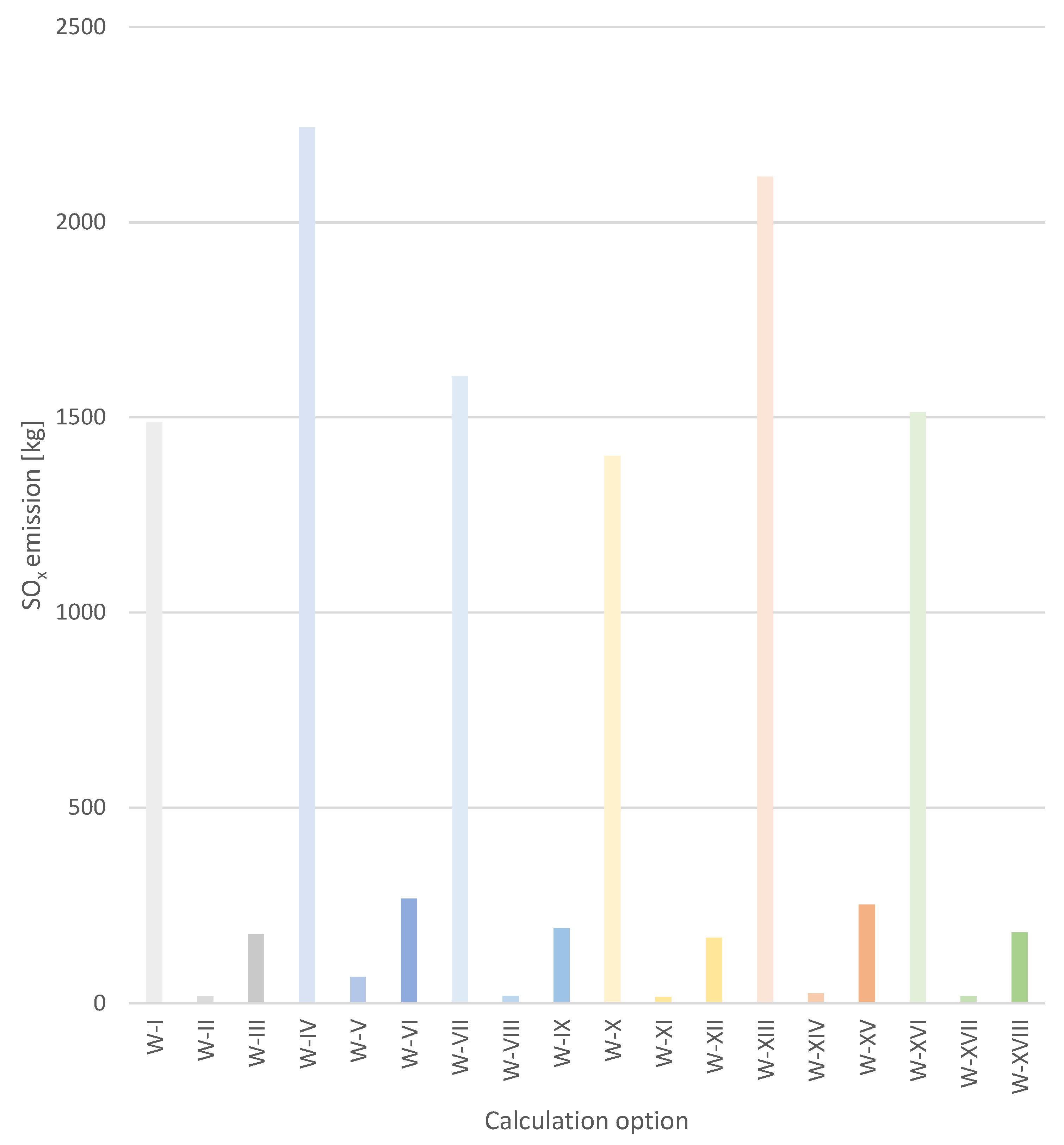
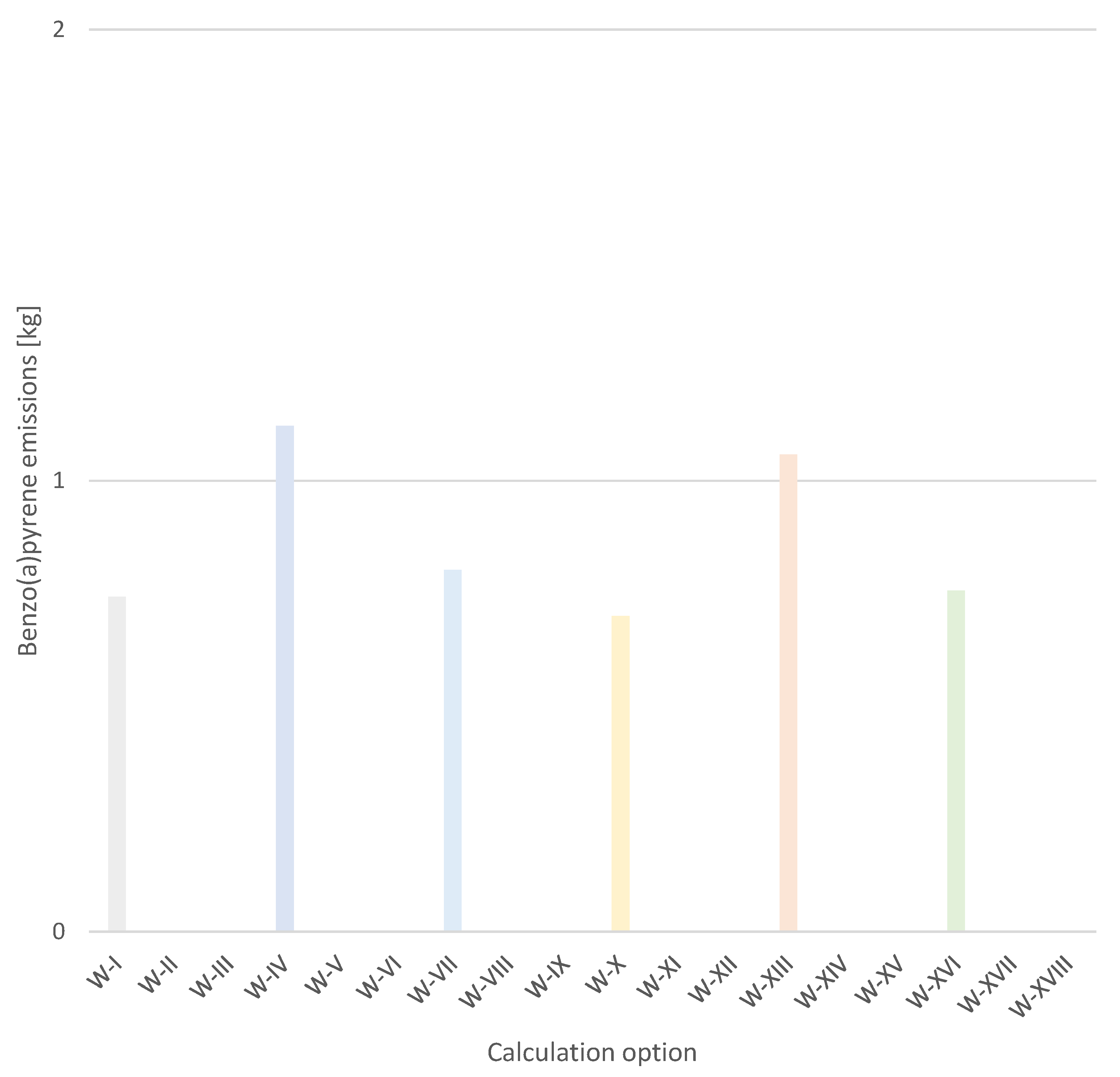


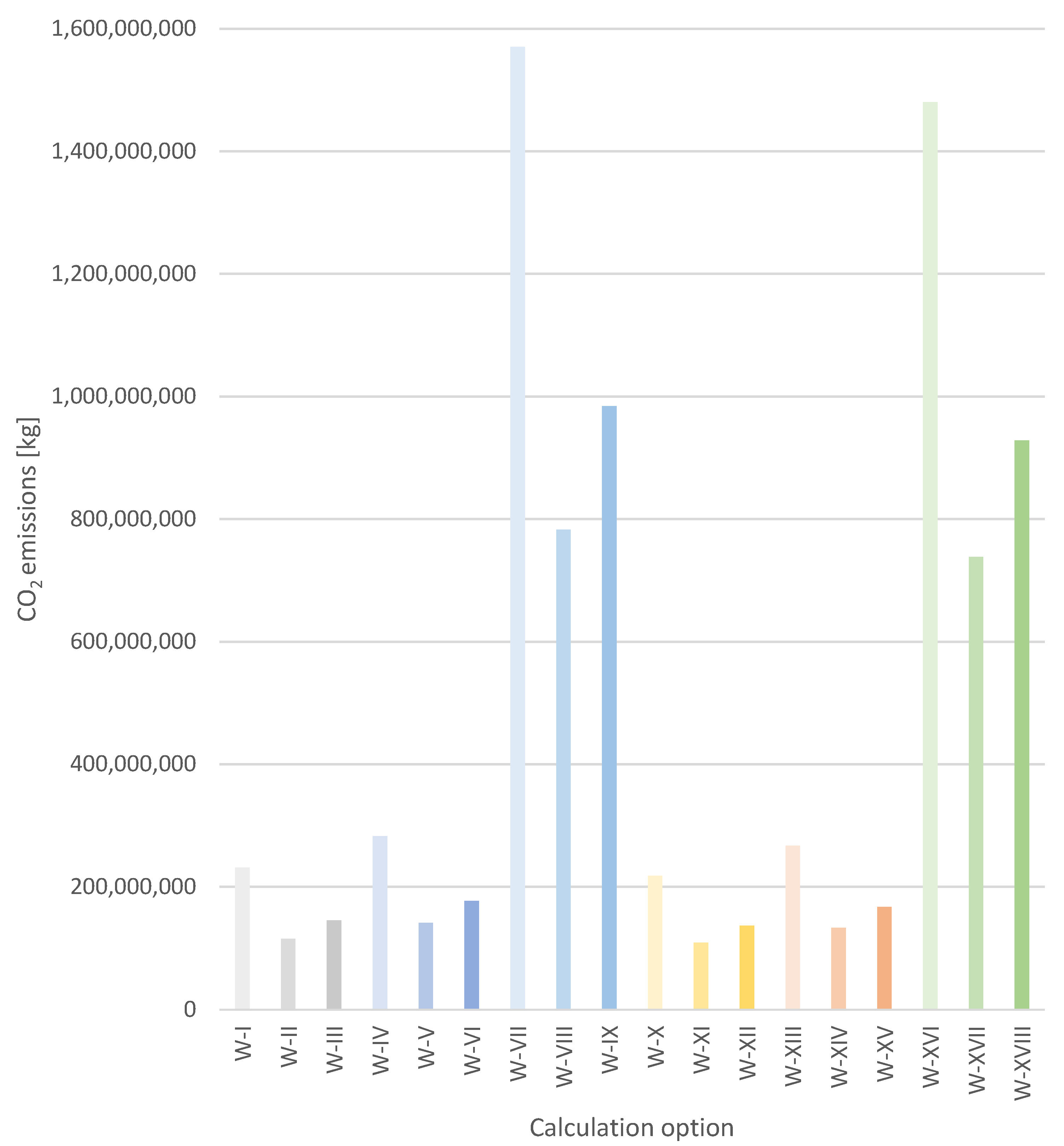

| Assumptions | Calculation Options | ||||||||||||||||||
|---|---|---|---|---|---|---|---|---|---|---|---|---|---|---|---|---|---|---|---|
| W-I | W-II | W-III | W-IV | W-V | W-VI | W-VII | W-VIII | W-IX | W-X | W-XI | W-XII | W-XIII | W-XIV | W-XV | W-XVI | W-XVII | W-XVIII | ||
| Material and construction floor solutions | - Concrete C12/15, 20 cm, | x | x | x | x | x | x | x | x | x | |||||||||
| - Gravel and sand ballast 20 cm, | |||||||||||||||||||
| - Sandy clay | |||||||||||||||||||
| - Concrete C12/15, 10 cm, | x | x | x | x | x | x | x | x | x | ||||||||||
| - Extruded polystyrene XPS 10 cm, | |||||||||||||||||||
| - Concrete C12/15, 20 cm, | |||||||||||||||||||
| - Gravel and sand ballast 20 cm, | |||||||||||||||||||
| - Sandy clay | |||||||||||||||||||
| Boiler | 150 kW | x | x | x | x | x | x | ||||||||||||
| fine coal boiler | |||||||||||||||||||
| 2 × 70 kW | x | x | x | x | x | x | |||||||||||||
| gas heater | |||||||||||||||||||
| 2 × 70 kW | x | x | x | x | x | x | |||||||||||||
| oil heater | |||||||||||||||||||
| Boiler efficiency [-] | 0.75 | x | x | x | x | x | x | ||||||||||||
| 0.9 | x | x | x | x | x | x | x | x | x | x | x | x | |||||||
| Location | Austria (Graz) | x | x | x | x | x | x | ||||||||||||
| Finland (Jyvaskyla) | x | x | x | x | x | x | |||||||||||||
| Germany (Kassel) | x | x | x | x | x | x | |||||||||||||
| Material | Volumetric Density [kg·m−3] | Specific Heat [J·kg−1·K−1] | Heat Transfer Coefficient [W·m−1·K−1] |
|---|---|---|---|
| Concrete C12/15 | 2200 | 850 | 1.60 |
| Mineral wool | 40 | 800 | 0.050 |
| Extruded polystyrene XPS | 40 | 1500 | 0.030 |
| Cellular concrete | 600 | 850 | 0.140 |
| Gravel and sand ballast | 1580 | 850 | 0.505 |
| Sandy clay | 1550 | 850 | 0.454 |
| Fuel | WO [MJ·kg−1] |
|---|---|
| Hard coal | 24.99 |
| Natural gas | 48.00 |
| Fuel oil | 40.40 |
| Pollutant | Hard Coal [g·GJ−1] | Gaseous Fuel [g·GJ−1] | Fuel Oil [g·GJ−1] |
|---|---|---|---|
| Total dust | 480 | 0.5 | 2 |
| CO2 | 96,370 | 57,650 | 72,480 |
| CO | 5040 | 30 | 30 |
| NOx | 170 | 40 | 70 |
| SOx | 560 | 0.4 | 80 |
| benzo(a)pyrene | 0.28 | 0.0000008 | 0.0001 |
Disclaimer/Publisher’s Note: The statements, opinions and data contained in all publications are solely those of the individual author(s) and contributor(s) and not of MDPI and/or the editor(s). MDPI and/or the editor(s) disclaim responsibility for any injury to people or property resulting from any ideas, methods, instructions or products referred to in the content. |
© 2024 by the authors. Licensee MDPI, Basel, Switzerland. This article is an open access article distributed under the terms and conditions of the Creative Commons Attribution (CC BY) license (https://creativecommons.org/licenses/by/4.0/).
Share and Cite
Nawalany, G.; Zitnak, M.; Michalik, M.; Lendelova, J.; Sokołowski, P. Impact of the Location and Energy Carriers Used on Greenhouse Gas Emissions from a Building. Energies 2024, 17, 4761. https://doi.org/10.3390/en17194761
Nawalany G, Zitnak M, Michalik M, Lendelova J, Sokołowski P. Impact of the Location and Energy Carriers Used on Greenhouse Gas Emissions from a Building. Energies. 2024; 17(19):4761. https://doi.org/10.3390/en17194761
Chicago/Turabian StyleNawalany, Grzegorz, Miroslav Zitnak, Małgorzata Michalik, Jana Lendelova, and Paweł Sokołowski. 2024. "Impact of the Location and Energy Carriers Used on Greenhouse Gas Emissions from a Building" Energies 17, no. 19: 4761. https://doi.org/10.3390/en17194761






